
Hart's Location is a town in Carroll County, New Hampshire, United States. Since 1948, the town has been one of the first places to declare its results for the New Hampshire presidential primary and U.S. presidential elections.

Crawford's Purchase is a township in Coös County, New Hampshire, United States. The purchase lies entirely within the White Mountain National Forest. As of the 2020 census, the purchase had a population of zero.

Mount Washington, in New Hampshire, is the highest peak in the Northeastern United States at 6,288.2 ft (1,916.6 m) and the most topographically prominent mountain east of the Mississippi River.
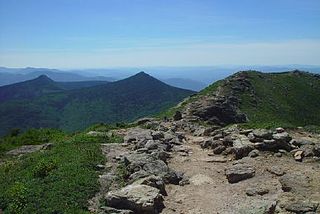
The White Mountains are a mountain range covering about a quarter of the state of New Hampshire and a small portion of western Maine in the United States. They are part of the northern Appalachian Mountains and the most rugged mountains in New England. The range is heavily visited due to its proximity to Boston, New York City, and Montreal.

Crawford Notch State Park is located on U.S. Highway 302, in northern New Hampshire, between Bretton Woods and Bartlett. The 5,775-acre (2,337 ha) park occupies the center of Crawford Notch, a major pass through the White Mountains.

Crawford Notch is a major pass through the White Mountains of New Hampshire, located in Hart's Location. Roughly half of that town is contained in Crawford Notch State Park. The high point of the notch, at approximately 1,900 feet (580 m) above sea level, is at the southern end of the town of Carroll, near the Crawford Depot train station and Saco Lake, the source of the Saco River, which flows southward through the steep-sided notch. North of the high point of the notch, Crawford Brook flows more gently northwest to the Ammonoosuc River, a tributary of the Connecticut River.
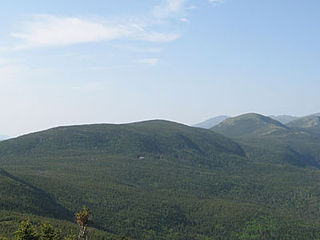
Bean's Grant is a township in southern Coös County, New Hampshire, United States, north of Crawford Notch State Park. The grant lies entirely within the White Mountain National Forest. The population was zero as of the 2020 census.

White Mountain art is the body of work created during the 19th century by over four hundred artists who painted landscape scenes of the White Mountains of New Hampshire in order to promote the region and, consequently, sell their works of art.
"The Ambitious Guest" is a short story by Nathaniel Hawthorne. First published in The New-England Magazine in June 1835, it was republished in the second volume of Twice-Told Tales in 1841.

Boott Spur is a minor peak located in Coos County, New Hampshire. The mountain is named after Francis Boott (1792–1863), and is part of the Presidential Range of the White Mountains. Boott Spur stands on the shoulder of Mount Washington, above the south side of the headwall of Tuckerman Ravine.

Mount Willey is a mountain located in Grafton County, New Hampshire. The mountain is named after Samuel Willey, Jr. (1766–1826) and his family, who in 1825 moved into a house in Crawford Notch. The family was killed a year later in August 1826 during a landslide.

Mount Tom is a mountain located in Grafton County, New Hampshire, about 1.5 miles (2.4 km) southwest of the height of land of Crawford Notch.
John Wingate Weeks was a U.S. Representative from New Hampshire, great uncle of John Wingate Weeks.

Crawford House was a grand hotel in Crawford Notch, New Hampshire, United States. The original hotel was built in 1850 and destroyed by fire in 1859. It was replaced by a second Crawford House resort that was the largest hotel in the White Mountains at the time. It was further expanded over time to accommodate 400 guests. The hotel featured wide porches and views of Crawford Notch. It eventually fell into disrepair and then closed in 1975. The hotel building was destroyed by fire in November 1977.
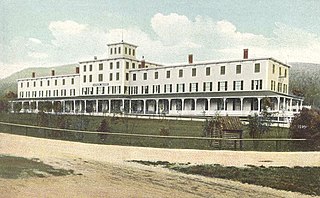
Fabyan House was a grand hotel in the White Mountains of New Hampshire, constructed by Sylvester Marsh who also built the Mount Washington Cog Railway. The hotel burned during construction in 1868 and was rebuilt in 1873. It was destroyed by fire in 1951.
William Oakes was an American botanist.
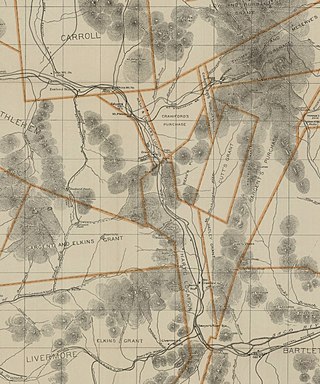
The Crawford family of the White Mountains were a family who moved to New Hampshire's White Mountains in the 1790s from Guildhall, Vermont, and were pioneers in establishing a tourist industry in that area. Abel Crawford and his father-in-law, Eleazar Rosebrook, began the effort, and one of Abel's sons, Ethan Allen Crawford, made significant contributions. Another son, Thomas Jefferson Crawford, continued the work; and Ethan's wife, Lucy, also contributed. Their work was in the area then known as White Mountain Notch, subsequently called Crawford Notch.
The History of the White Mountains from the First Settlement of Upper Coos and Pequaket was written by Lucy Crawford and first published in 1846, with a revised and expanded edition written in 1860 but not published until 1966.
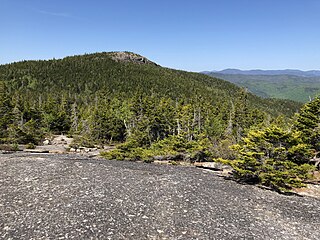
Mount Crawford is a mountain located in Coos County, New Hampshire, in the United States. The mountain is on a spur of Montalban Ridge within the White Mountains and overlooks Crawford Notch. It is accessible via the Davis Path, which climbs from Crawford Notch near the Notchland Inn. The Davis Path continues north up Montalban Ridge to Mount Washington.

The Crawford Path is an 8.5-mile-long (13.7 km) hiking trail in the White Mountains of New Hampshire that is considered to be the United States' oldest continuously maintained hiking trail. It travels from Crawford Notch to the summit of Mount Washington (Agiocochook). The first iteration of the Crawford Path was cut in 1819 by Ethan Allen Crawford and his father, Abel Crawford. The trail ascends a cumulative 4,900 feet (1,500 m), first through densely wooded forest for about 3.1 miles (5.0 km), then following the exposed southern ridge of the Presidential Range mostly above the treeline.

















